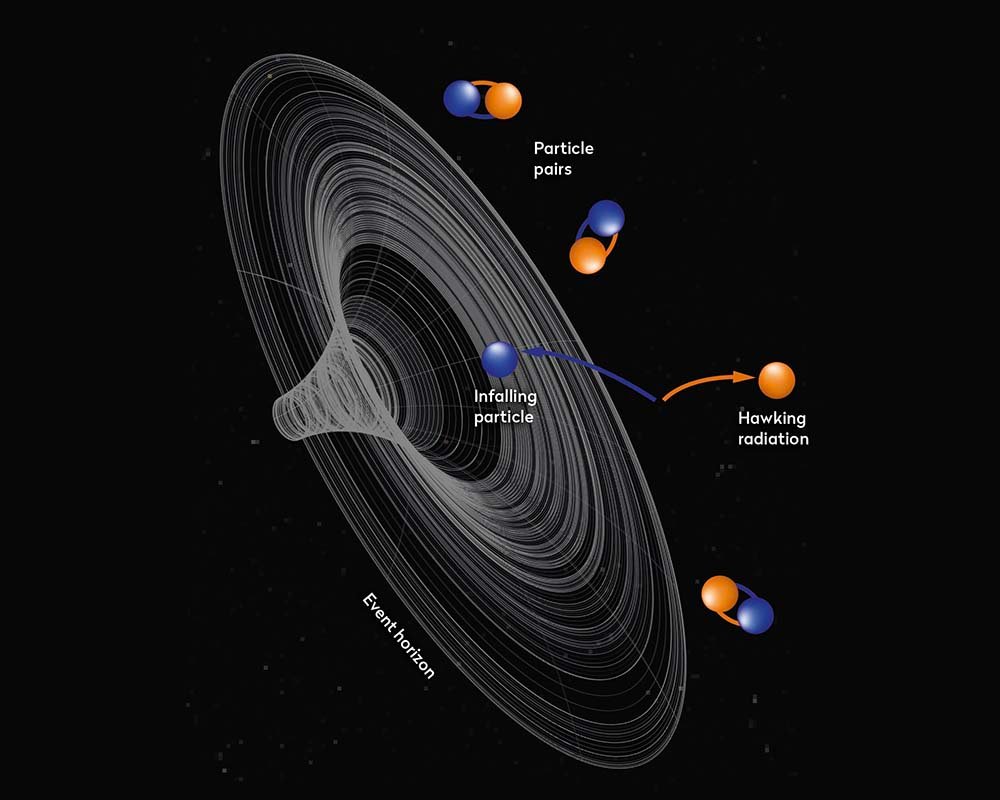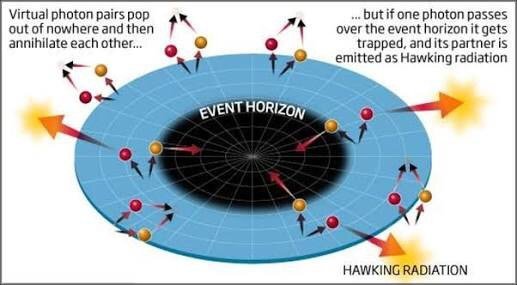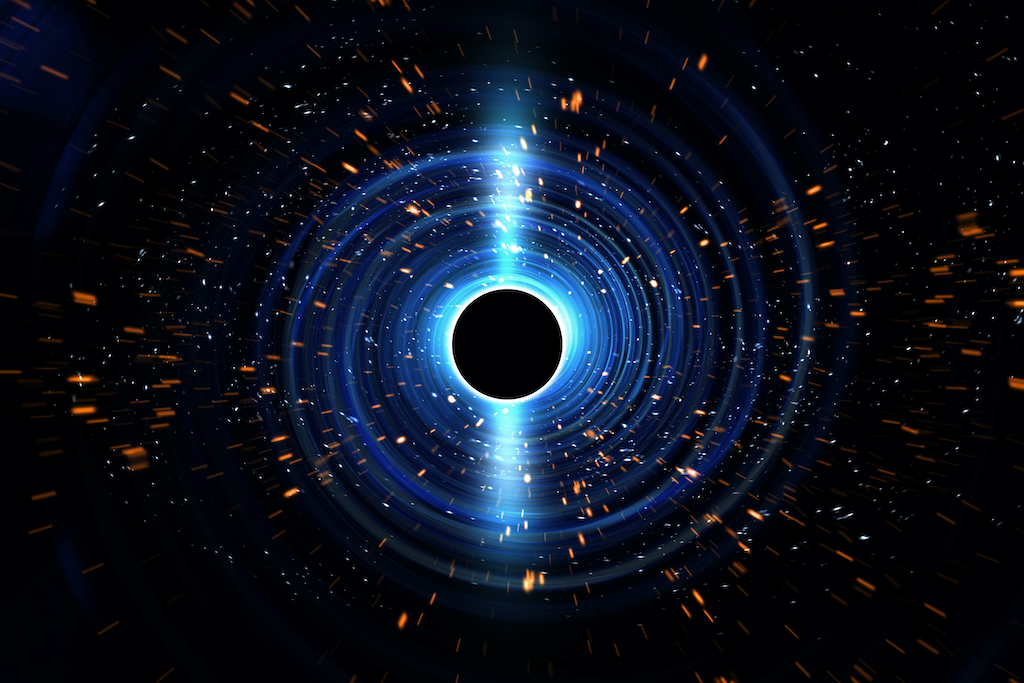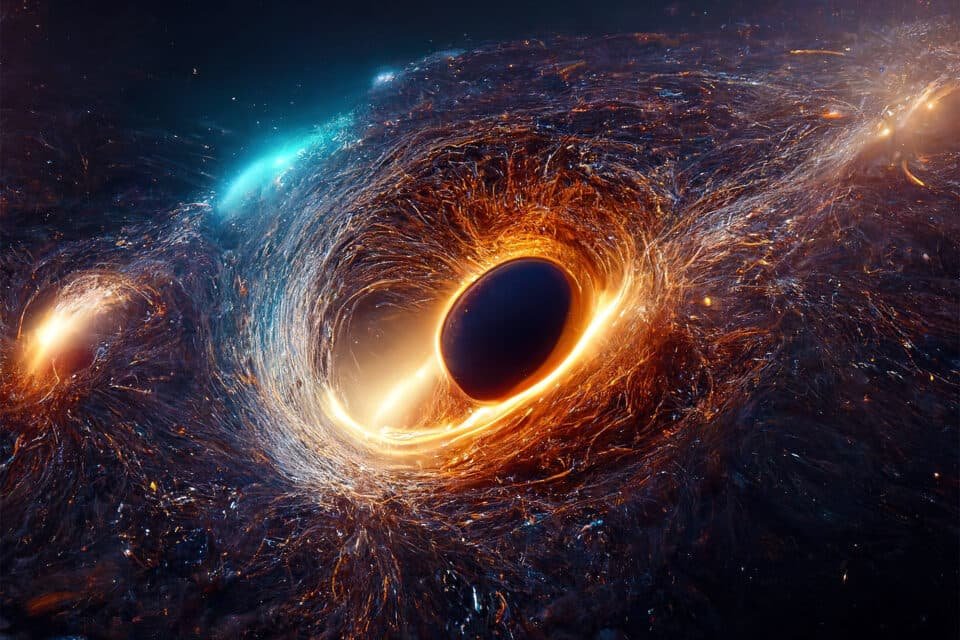What is the hawking radiation? Hawking radiation is a kind of thermal black-body radiation that is released outside from event horizon from a black hole. This is counterintuitive, because once ordinary electromagnetic radiation is inside the event horizon it can not escape at all.

Hawking radiation is a theoretical prediction by physicist Stephen Hawking that black holes are not completely black but emit small amounts of thermal radiation due to quantum effects near the event horizon. This radiation results from the creation of pairs of virtual particles – one falling into the black hole and the other escaping, which to an outside observer appears as radiation emitted by the black hole. Over time, this can lead to the gradual loss of mass and energy from the black hole, eventually causing it to evaporate completely.
Hawking radiation arises from the quantum mechanical principle that the vacuum of space is not truly empty but is filled with virtual particles and antiparticles that spontaneously form and then quickly annihilate each other. However, near the event horizon of a black hole, these virtual particles can be separated by the intense gravitational field.
Let’s have more detailed breakdown of the process below:

- Particle-Antiparticle Pairs: In empty space, a particle and its antiparticle can appear spontaneously due to quantum fluctuations and then annihilate each other in a very short time frame.
- Event Horizon: This is the boundary around a black hole from which nothing, not even light, can escape. If a particle-antiparticle pair forms very close to the event horizon, it’s possible for one particle to fall into the black hole while the other escapes.
- Escape of Radiation: The particle that escapes carries away energy in the form of radiation, which we observe as Hawking radiation. This energy is theorized to come from the black hole’s mass, leading to a decrease in its mass over time.
- Black Hole Evaporation: If this process continues, it could lead to the black hole losing mass and eventually evaporating completely, although this would take an incredibly long time for most black holes.
Hawking radiation has not yet been observed directly due to its expected weak emission making it difficult to detect against the cosmic background. However, it has significant implications for our understanding of physics, including the nature of black holes, quantum mechanics, and general relativity. In terms of space technology and exploration, while Hawking radiation itself may not have direct applications, the physics behind it could potentially lead to new technologies or methods of harnessing energy in space.
What is the hawking radiation? Explaining mathematically.
Hawking radiation can be described mathematically by a formula that relates the temperature of the radiation to the mass of the black hole. The temperature ( T ) of Hawking radiation is given by:

This formula shows that the temperature of the radiation is inversely proportional to the mass of the black hole, meaning smaller black holes emit hotter and more intense radiation. It’s a fascinating aspect of quantum mechanics and general relativity coming together.
Explaining Planck’s constant
Planck’s constant, denoted by ( h ), is a fundamental physical constant that is of foundational importance in quantum mechanics. It relates the energy of a photon to its frequency through the equation ( E = hf ), where ( E ) is energy and ( f ) is frequency. This constant also relates to the wavelength ( \lambda ) of a particle’s matter wave through the equation ( \lambda = \frac{h}{p} ), where ( p ) is the momentum of the particle.
In essence, Planck’s constant sets the scale at which quantum effects become significant. It defines how energy is quantized and exchanged at the atomic level, meaning that energy is not continuous but comes in discrete packets called quanta. This discovery by Max Planck in 1900 was pivotal in the development of quantum mechanics and has led to a deeper understanding of the nature of light and matter.
What happens when a black hole emits Hawking radiation?
When a black hole emits Hawking radiation, it gradually loses mass and energy. This process is known as black hole evaporation. Over time, if a black hole does not gain mass from other sources, such as absorbing matter from its surroundings, it will continue to emit radiation, shrink, and eventually vanish.
For most black holes, this evaporation process is extremely slow, taking much longer than the current age of the universe to have any significant effect. However, for very small black holes, the process could be relatively rapid. Theoretically, as they lose mass, they would emit more intense radiation and could end their life in a burst of energy.
This concept is fascinating because it suggests that black holes are not eternal and that they can change over time due to quantum mechanical effects. It’s a beautiful example of how even the most massive objects in the universe are subject to the laws of physics at the smallest scales.
How does this relate to information loss paradox?
The black hole information loss paradox is closely related to Hawking radiation and arises from a conflict between quantum mechanics and general relativity. According to quantum mechanics, information about a physical system is never lost, not even when that system disappears. However, if a black hole evaporates completely through Hawking radiation, it seems that any information that fell into it would be lost forever.
This paradox challenges our understanding of physics because it suggests that either quantum mechanics or general relativity—or perhaps both—might need to be revised to account for this phenomenon. Some physicists believe that the information is not lost but somehow encoded in the Hawking radiation itself, although there is no consensus on how this would work. The information loss paradox remains one of the most important unsolved problems in theoretical physics and continues to fuel research and debate in the scientific community.
What are some proposed solutions to the information loss paradox?
Several solutions have been proposed to resolve the black hole information loss paradox. Here are a few of the main ideas:
- Black Hole Remnants: Some theories suggest that black hole evaporation could stop at a certain point, leaving behind a small but stable remnant that contains all the lost information.
- Holographic Principle: This principle posits that all the information contained in a volume of space can be represented as a hologram—a two-dimensional surface that encodes the entire three-dimensional space. Applied to black holes, it suggests that information is not lost but stored on the event horizon.
- Firewalls: A controversial idea that suggests an energetic barrier (firewall) forms at the event horizon, which would release information as it interacts with incoming matter and Hawking radiation.
- Quantum Hair: The “no-hair” theorem states that black holes can be described by just three properties: mass, charge, and angular momentum. However, “quantum hair” theories propose additional quantum properties that could encode information and resolve the paradox.
- AdS/CFT Correspondence: This is a theoretical framework that describes a relationship between two kinds of physical theories. In simple terms, it suggests that a quantum field theory without gravity in a lower dimension (like on the boundary of a space) can be equivalent to a gravity theory in higher dimensions (like in the bulk of the space), including black holes.
Unveiling the Mystery of Hawking Radiation
Hawking radiation arises from the quantum mechanical principle that pairs of virtual particles constantly pop into and out of existence in the vacuum of space. Near the event horizon of a black hole, these particle pairs can be separated by the intense gravitational pull; one particle falls into the black hole while its partner escapes into space, appearing as radiation emitted by the black hole.

This phenomenon has profound implications for our understanding of physics, suggesting that black holes are not eternal and can evaporate over time. As they emit Hawking radiation, they lose mass, shrinking gradually until they could theoretically disappear entirely.
But Hawking radiation also presents a paradox: if a black hole eventually evaporates completely, what happens to the information it contained? This question challenges the fundamental principles of quantum mechanics and has led to a plethora of theoretical explorations. As research continues, we edge closer to understanding the true nature of black holes and the fabric of spacetime itself. Hawking radiation is a beacon in the dark, guiding us through one of the most intriguing puzzles in cosmology.
How does Hawking radiation affect supermassive black holes?
Hawking radiation has a significant but slow effect on supermassive black holes. While all black holes are theorized to emit Hawking radiation, leading to a gradual loss of mass and energy, the process is incredibly slow for supermassive black holes due to their vast size.

Supermassive black holes, with masses millions or billions of times that of the Sun, would take much longer than the current age of the universe to evaporate completely through Hawking radiation. In fact, the radiation is so faint that it is many orders of magnitude below our current best telescopes’ detecting ability.
The smaller a black hole is, the faster it would leak Hawking radiation. Therefore, supermassive black holes are expected to evaporate very slowly, potentially over trillions of years, making the effect of Hawking radiation on them practically negligible in human timescales.
